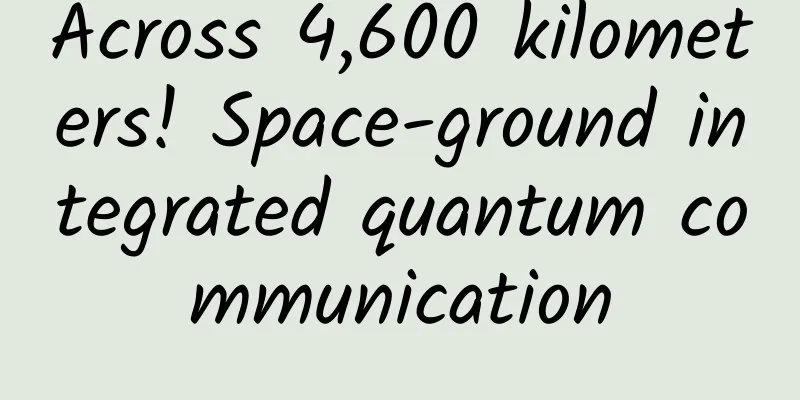Four low-Earth orbits are running simultaneously! my country's "precipitation star" has become a regular star!

|
On May 1, Fengyun-3G, which we often call the "mercury precipitation star", was officially put into operation. Fengyun-3G was successfully launched on April 16, 2023. It is China's first low-inclination orbit precipitation measurement satellite, which is mainly used for precipitation climatology research and precipitation monitoring of disastrous weather systems , and can provide three-dimensional precipitation structure information in mid- and low-latitude regions around the world. Its successful launch makes China the only country in the world that simultaneously operates four low-Earth orbit civil meteorological satellites in the morning, afternoon and inclined orbits. Image source: CCTV News Chen Lin, deputy chief designer of the ground system of Fengyun-3G, said that global observation of precipitation, especially observation of three-dimensional structure, has always been a difficult problem in meteorological detection. The launch of my country's "Precipitation Satellite" has actually taken my country's global observation capability of precipitation and three-dimensional structure detection capability to a new level. The “unique skills” of Fengyun-3G 01 Take a “CT” of precipitation Traditionally, precipitation data is obtained mainly through rain gauges, ground-based radars and other means. However, due to the limited number and uneven distribution of ground equipment, it is difficult to obtain ground precipitation information with high spatial resolution over a large area. Fengyun-3G is equipped with my country's first "airborne rain gauge" - a satellite-borne Ku and Ka dual-frequency precipitation measurement radar, which combines the advantages of high radar observation resolution and wide satellite observation range. It can transmit radio electromagnetic wave signals to the atmosphere, receive reflection signals from precipitation particles at different altitudes in the atmosphere, obtain precipitation structure information at different altitudes in the vertical direction, and realize the detection of precipitation in the vertical direction. At the same time, the satellite can also use the radar's cross-track scanning capability to detect precipitation in the horizontal direction, thereby having the ability to obtain three-dimensional structural information from top to bottom, just like a "CT" scan of atmospheric precipitation. 02 Accurate diagnosis of typhoons and rainstorms Fengyun-3G, also called "precipitation star" by the meteorological department, is my country's 20th Fengyun meteorological satellite. It is my country's first satellite to actively measure precipitation. Through the fusion of satellite and ground radar, it can realize the detection of global three-dimensional atmosphere, cloud and precipitation structure. It will be used in typhoon, rainstorm and other extreme weather disasters monitoring and forecasting and climate research, and significantly improve the early warning capabilities of global rainstorm and other disasters. At the same time, it plays a role in the fields of ecological environment, energy, agriculture, health, etc. 03 Dance "Space Ballet" flexibly Fengyun-3G is operating in a low-orbit, low-inclination, non-sun-synchronous orbit. The sun will appear regularly on the left and right sides of the orbital plane. The constant changes in lighting conditions make the satellite's external thermal environment complex. To ensure the stability of the external thermal environment and the single-machine working environment, the satellite needs to keep the same side facing the sun at all times. To this end, the attitude and orbit control system has designed an autonomous yaw attitude maneuver mode. When the sunlight moves from one side of the orbital plane to the other, the satellite will automatically complete a 180-degree turn and perform a "space ballet" in a flexible manner. In addition, the orbit of Fengyun-3G is about 407 kilometers above the ground, and the atmospheric density is relatively high. In years with high solar activity, the satellite's orbital altitude can decay by more than 600 meters in one day. According to mission requirements, the satellite's orbital altitude must be controlled within a deviation of 100 meters. The research and development team has gathered collective wisdom to achieve the coordinated autonomous control of satellite orbital altitude maintenance, eccentricity and orbital phase, so that the satellite can always pass over the same latitude area at a fixed altitude to ensure its business application efficiency. Fruitful results during the “trial period” Since October 23, 2023, Fengyun-3G has completed more than 6 months of business trial operation. During the trial operation, the satellite-ground system operated stably, and under the conditions of normal status of the satellite platform, onboard payload, satellite measurement and control, the four assessment indicators of data reception, data processing, product distribution and data archiving success rate have all met the standards. During the in-orbit testing and trial operation, Fengyun-3G not only achieved obvious application effects in the analysis of high-impact weather during the flood season, and meteorological service guarantee for the flood season and major events such as the Chengdu Universiade and the Hangzhou Asian Games, but also successfully detected the three-dimensional structure of extreme rainstorms in Brazil, Maldives and other countries, and played an application benefit in serving the international community. Comprehensive sources: CCTV News, National Satellite Meteorological Center, Science and Technology Daily, China Meteorological Administration, etc. |
<<: 7 kinds of "aging agents" hidden in daily food, try to avoid them!
>>: To avoid motion sickness during holidays, the key is to pay attention 2 hours before boarding!
Recommend
What are the effects of chrysanthemum honeysuckle tea
Chrysanthemum and honeysuckle tea is mainly compo...
The efficacy of apricot-scented rabbit ear wind
Xingxiang Rabbit Ear Wind is the name of a Chines...
Will fast charging damage the battery? Avoid misunderstandings and learn to charge scientifically →
In today's fast-paced urban life, many people...
How to tell if you are okay after hitting your head
It is inevitable that we will stumble and fall in...
Is it more economical to refuel in the morning? Check out the common misconceptions about refueling in life
Is it more economical to refuel in the morning th...
World Autism Day: Caring for “Children from the Stars”
They live among us But I have a heart that can on...
The efficacy and function of iron powder
We know that there are many kinds of Chinese medi...
Chaihu Anshen Granules
Nowadays, many people have varying degrees of sle...
The efficacy and function of Haizhou Drynaria
Only when we understand the main ingredients of a...
The efficacy and function of Guangming salt
Guangming salt is often used as a medicinal ingre...
The efficacy and function of banana root
Ganjiao root is a kind of traditional Chinese med...
The Difference Between Rhodiola Rosea and Saffron
Rhodiola rosea and saffron are two medicines that...
The efficacy and function of red sugar
Brown sugar is usually used as a medicinal ingred...
The efficacy and function of Primula
In today's society, health preservation seems...
Pictures of rickets grass
Have you ever heard of the herb rickets grass? It...







![[One picture to understand] What are the rules for naming Chinese naval ships?](/upload/images/67f0e7888b947.webp)

